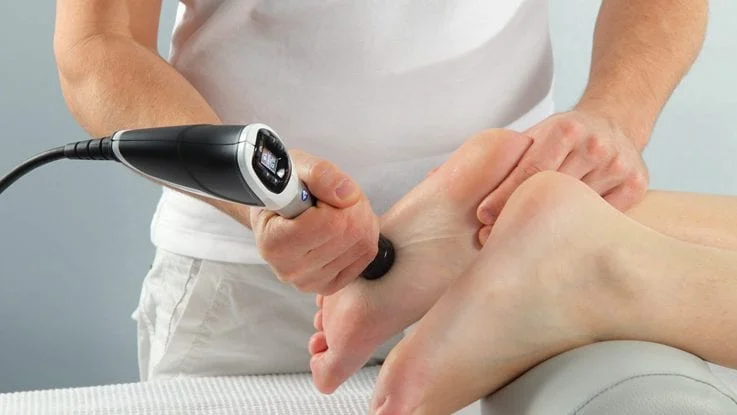Plantar Fasciitis (PF) is the most common cause of foot pain of the approximate 2 million people who seek treatment annually (Surgeons, 2010). The specific etiology is most commonly unknown and pain occurs suddenly and without warning.
Treatment recommendations for PF as described along with the strength of evidence are provided in the JOSPT clinical guidelines. These include: anti-inflammatory agents (advising patients concerning NSAIDS and steroid injections), Iontophoresis, Manual Therapy, Stretching, Taping Techniques, Orthotic Devices, and Night Splints (McPoil, Martin, Cormwall, Wukich, Irrgang, & Godges, 2008). The limitation of this guideline is the absence of further recommendations after possible unsuccessful outcomes.
Treatment recommendations for PF are described using 3 tiers of a treatment ladder in the JT&AS clinical guidelines ((ACFAS), 2010). The 1st tier is the use of padding and strapping, stretching, OTC arch support, heel cups [if fat pad atrophy is present], shoe gear recommendations, oral anti-inflammatories, and/or corticosteroid injection. The 2nd tier consists of: corticosteroid injection, custom orthotics, night splints, immobilization, and/or Rx Physical Therapy.
Tier 3 consists of either Extracorporeal Shock Wave Therapy (ESWT) or Fasciotomy with or without nerve release. Tier 3 is considered chronic and conservative treatment has been tried for at least 6 months ((ACFAS), 2010). Both clinical guidelines agree that approximately 90% of the patients with PF will resolve with conservative interventions, but 10% remain chronically involved. Extracorporeal Shock Wave Therapy (ESWT) is a relatively new device here in the United States and it is not a common topic of discussion in the health care field.
Extracorporeal Shock Wave Therapy has been used in Europe for over 20 years. In North America it has only been used since 1996. In 2005, the American Food and Drug Administration (FDA) accepted two new types of ESWT devices for the treatment of tennis elbow and PF (Gerdesmeyer & Weil, Extracorporea Shockwave Therapy, 2007).
ESWT releases high intensity acoustic pressure waves into the target tissue (Iorio, Rode, & Hart). The exact mechanisms of physiological effects of ESWT are unknown. The two major principles of therapeutic effect are: alleviation of pain by increasing blood flow and decreasing the inflammation, and damage of the cell membranes which, this author states, interferes with the transmission of pain signals to the brain (Gerdesmeyer & Weil, Extracorporea Shockwave Therapy, 2007) (Iorio, Rode, & Hart). Extracorporeal Pulse Activation Treatment (EPAT) is the name of the Low Energy device that we are currently using here at Foot & Ankle Specialists of West Michigan.
It is administered with a hand held applicator, requires 3 treatments and each treatment takes approximately 5-10 minutes, 1-2 weeks apart. EPAT is well tolerated and therefore does not usually require any use of anesthesia, nerve block, or sedation. You will be able to walk out of the procedure and resume normal weight bearing activities.
There is much evidence to support ESWT. Most of the research that is currently published demonstrates statistically significant improvements in patient reported heel pain in over 85% of the participants in the studies. The primary agreement among the articles that implemented ESWT was a reduction in heel pain.
The majority of the quality studies reported that these chronic plantar heel patients would have to either undergo a surgical procedure, which involves risks, or to continue to suffer with the condition and hope that it would eventually improve in time. ESWT interventions are demonstrating effective and long-term pain relief in PF and other chronic musculoskeletal conditions from these studies and many others.
References
- (ACFAS), A. C. (2010). The Diagnosis And Treatment of Heel Pain. The Journal of Foot & Ankle Surgery , 49 (35), 51-57.
- McPoil, T. G., Martin, R. L., Cormwall, M. W., Wukich, D. K., Irrgang, J. J., & Godges, J. J. (2008).
- Heel Pain-Plantar Fasciitis: Clinical Practice Guidelines Linked to the International Classification of Function, Disability, and Health from the Orthopaedic Section of the American Physical Therapy Association. The Journal of Orthopaedic & Sports Physical Therapy , 38 (4), A1-A18.
- Gerdesmeyer, L., & Weil, L. (2007). Extracorporea Shockwave Therapy. Towson, MD: Data Trace Publishing Company.
- Iorio, A. R., Rode, K. W., & Hart, B. J. Extracorporeal Pulse Activation Technology (EPAT) in Acute and Chronic Musculoskeletal Pain of the Lower Extremity: A Case Report. New York College of Podiatric Medicine. New York: Storz Medical



